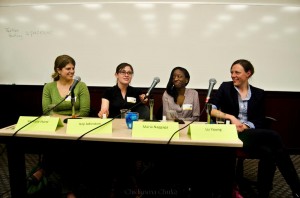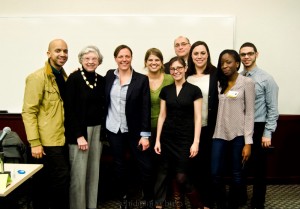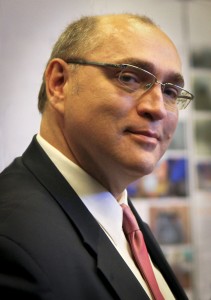Nina Freeman, a graduate student of Computer Science at the Seidenberg School, recently attended the IndieCade East Indie Game Festival after working on her own game at the Playstation Mobile Game Jam. She was kind enough to write about her experience for our blog. Nina’s previously written for our Tumblr about the NYU Global Game Jam and you can read that piece here. Read on ahead for an exciting account of a Seidenberg student developing her own gam
 Nina Freeman, a graduate student of Computer Science at the Seidenberg School, recently attended the IndieCade East Indie Game Festival after working on her own game at the Playstation Mobile Game Jam. She was kind enough to write about her experience for our blog. Nina’s previously written for our Tumblr about the NYU Global Game Jam and you can read that piece here. Read on ahead for an exciting account of a Seidenberg student developing her own game.
Nina Freeman, a graduate student of Computer Science at the Seidenberg School, recently attended the IndieCade East Indie Game Festival after working on her own game at the Playstation Mobile Game Jam. She was kind enough to write about her experience for our blog. Nina’s previously written for our Tumblr about the NYU Global Game Jam and you can read that piece here. Read on ahead for an exciting account of a Seidenberg student developing her own game.
“IndieCade East, the first time IndieCade has been held on the east coast, took place during the weekend of February 15th. However, for me, IndieCade began the weekend prior with the PlayStation Mobile (PSM) Game Jam. The PSM Game Jam was a weeklong collaboration between Sony and IndieCade that brought together a group of developers based in the New York City area. Our task was to develop games for the PSVita during the week leading up to, and the weekend of, IndieCade East. It was a unique opportunity to take the technology offered by Sony, and to use it to make a game of our own design. All teams were given access to the PSM SDK, a yearlong publishing license for the PSVita, and most importantly to developers that worked on creating the SDK itself. It was exciting to have the help of Sony developers’ in-person, especially because none of us jammers had any experience with the SDK beforehand.
The most exciting and challenging part of the SDK was that it uses C#. I had no experience with C# prior to the jam. Needless to say, by the end of IndieCade I felt like a C# savant. The week leading up to our final presentations was an absolute rollercoaster, during which I learned more about games programming than I ever dreamed of. My teammate and fellow programmer Emmett Butler pair programmed with me for the first 2 days of the jam. I can’t even begin to tell you how helpful the pair programming approach was. It was by far the most productive way we could have taught ourselves C# in such a short amount of time, because we were able to both learn the SDK while also setting up the basic framework for our game. Once we had an understanding of the SDK, we started to build our game, which would come to be called Cybrid 7-x.
Cybrid 7-x was our first response to the jam’s theme of “evolution.” We wanted to create a self-reproducing system, mostly because it was an interesting experiment in code. From that idea came a robot stuck in a garden full of over-zealous plant life. Our game is essentially a flower breeding game in which you try to control the types of flowers that are reproduced. For example, if you plant the rose next to the mushroom, the next generation that spawns will be a combination of the two. The actual reproduction happens when it rains or if you choose to water the plants. The goal is to breed the plant that appears on the computer screen in your garden, and to plant it in the plot below the screen. If you let the flowers get too out of control, they take over your garden and you lose. The game sounds simple, but it took us the entire week, up to the very last minute, to really fine-tune our idea. The Sony developers were extraordinarily helpful in untangling some of our tougher problems. My team found z-indexing within the SDK to be quite the puzzle, but the Sony developers did their best to help us put the pieces together. Having that kind of support during the crunch of a game jam is very encouraging.
I was happy to meet so many talented programmers and designers throughout the jam, from both Sony and elsewhere. It was really rewarding to participate in an event where everyone was so clearly excited about games and making them. Seeing the other teams games at the final presentation was really inspiring. It’s incredible to see what kinds of ideas can come out during the hectic atmosphere of a game jam. I’m a big fan of game jams, and hope to do more in the future. I feel very lucky to have worked with Sony and with my amazing teammates. You can check out our tumblr,donutgoku.tumblr.com, to see some screenshots of the game. If you ever get a chance to do a game jam, go for it! You never know what kind of exciting ideas will come out of it.”
Sounds like she had a great time. Do you have your own Game Jam or Development weekend story you’d like featured on our blog? Shoot us an e-mail to paceseidenbergschool@gmail.com. If you’d like to contact Nina you can reach her at nf20069n@pace.edu nf20069n@pace.edu.
 This lecture will focus on how Telehealth solutions can improve the quality of health care globally and contribute specifically to improving the healthcare system of the US. Telehealth involves the use of electronic information and communication technologies to support clinical health care, personal health management, health-related education, and collaboration between health care providers. Through the use of Telehealth technologies, we can improve patient care, prevent adverse health-related events, reduce costs, reduce time delays, and provide deeper insight to develop curative solutions. This lecture will include a discussion of the complex regulatory and public policy issues that simultaneously foster and inhibit innovation and delivery to the market, as well as a delineation of the key emerging sub-areas of Telehealth.
This lecture will focus on how Telehealth solutions can improve the quality of health care globally and contribute specifically to improving the healthcare system of the US. Telehealth involves the use of electronic information and communication technologies to support clinical health care, personal health management, health-related education, and collaboration between health care providers. Through the use of Telehealth technologies, we can improve patient care, prevent adverse health-related events, reduce costs, reduce time delays, and provide deeper insight to develop curative solutions. This lecture will include a discussion of the complex regulatory and public policy issues that simultaneously foster and inhibit innovation and delivery to the market, as well as a delineation of the key emerging sub-areas of Telehealth.






